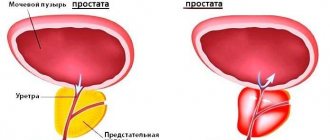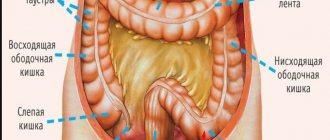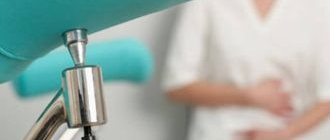The disease can manifest itself acutely or be indolent with remissions and relapses.
It affects one pipe or both at the same time. The cavity filled with transudate can be one or divided by partitions into several chambers. The diameter of the pipe increases from several millimeters to several centimeters, and the walls become thinner. Due to poor circulation, swelling of the fimbriae occurs. The main complication of hydrosalpinx is infertility, which is caused not only by obstruction of the oviduct, but also by a constantly maintained inflammatory process that prevents embryo implantation, causes damage incompatible with life and miscarriages in early pregnancy.
Treatment of hydrosalpinx is carried out conservatively or more effectively surgically. If it is impossible to completely restore the functionality of the oviduct, or there is a relapse, tubectomy is recommended in many cases to prevent complications.
Causes
The main reason for the formation of hydrosalpinx is adnexitis (salpingitis). Complications are almost guaranteed in the presence of factors such as:
- Hypothermia. It provokes activation of opportunistic microflora and weakening of the body's protective functions. The result is the formation of pus in the appendages.
- Endometriosis, which worsens the patency of the tubes.
- Abortions and miscarriages (during curettage, the appendages are damaged and infection occurs).
- Surgeries on the uterus and ovaries (later scars and adhesions occur).
- Infections of the genitourinary area (provoke an inflammatory process in neighboring organs).
- An unsuccessfully installed intrauterine device.
- Violent sexual life without protection (STIs are provocateurs of many diseases of the female genital area).
- Endometritis (inflammation of the uterus).
- Uterine fibroids near the appendages (the formation puts pressure on the fallopian tubes, causing adhesions)
- Adhesions in the pelvic area (the main cause of hydrosalpinx).
- Violation of the vaginal microflora (the infection is transferred to the uterus and spreads through the fallopian tubes).
- The cause of hydrosalpinx on the right is chronic or acute appendicitis.
Factors that cause hydrosalpinx also include endocrine diseases (diabetes, thyroid pathology), severe or constant stress, constant hypothermia (exercise on ice, in cold water).
Types of disease and pregnancy prognosis
The disease is classified based on the following factors.
Liquid composition:
- A simple accumulation of serous fluid is a hydrosalpinx.
- The presence of pus impurities is called pyosalpinx.
- The presence of blood impurities inside the formation is hematosalpinx.
- A neoplasm in the fallopian tube with contents inside is a sactosalpinx.
By location:
- Left-sided hydrosalpinx of the ovary
, in which the patency of the left-sided fallopian tube is disrupted, is the most common. In this case, fertilization occurs in a healthy right appendage. In the acute course of the disease, the symptoms are pronounced: the temperature rises, the state of health worsens, and pain in the lower abdomen occurs. - Right-handed
. Hydrosalpinx on the right side differs from the left side only in its location. - Bilateral hydrosalpinx
. A consequence of prolonged inflammation and the formation of adhesions. It significantly increases the risk of infertility because it blocks the normal circulation of serous fluid in the appendages.
According to symptoms and duration of treatment:
- Acute, with bright signs.
- Chronic. If the disease is not treated, the severity of the symptoms will subside, and the patient will be diagnosed with chronic hydrosalpinx.
According to the form of the neoplasm:
- tubular;
- bell-shaped;
- oval;
- irregular shapes.
According to morphological features:
- Simple
(the formation is a single capsule with liquid inside). - Follicular hydrosalpinx.
B is expressed in multiple formations inside the fallopian tube, filled with fluid and not interconnected (capsules of different sizes and shapes, separated from each other by partitions 1-4 mm thick). Pain on the right side is sometimes perceived as an attack of appendicitis, and the patient does not immediately seek help. Follicular hydrosalpinx requires surgical intervention. - Valve (with partial release of liquid mixed with mucus to the outside, when adhesions periodically break through).
Vent hydrosalpinx of the left tube is a variant of chronic pathology. It also occurs on the right side, but is more often left-sided. It is formed in cases where the adhesive process does not block the lumen of the appendage, and the adhesions themselves remain soft and elastic. Under the pressure of the accumulating serous fluid, the hydrosalpinx cavity stretches and bursts, and the contents pour into the pipes and from there into the vagina. A woman recognizes this by watery discharge and acute pain in the lower abdomen.
If the size of the ruptured capsule is small, then the ventilated form of the disease does not cause discomfort, although the problem must be eliminated.
Physiotherapy for sactosalpinx - what is it?
In order to prevent adhesions, a course of physiotherapy is carried out immediately after the operation. A drug is injected into the site of inflammation during physiotherapeutic procedures. These include laser phoresis, magnetophoresis, ultrasound, electromagnetophoresis, diathermy and mud therapy.
Due to the risk of atrophy of the ciliated (ciliated) epithelium of the fallopian tubes, treatment of sactosalpinx should be timely. The advancement of the egg is helped by the rhythmic movements of the cilia that line the fallopian tube. The risk of infertility or ectopic pregnancy increases with their atrophy.
This disease is considered a source of infection in which bacteria multiply. The formation of adhesions may occur, limiting the focus of inflammation, if the necessary treatment is not provided for the long-term existence of this disease. Plastic peritonitis, characterized by acute constant pain, begins to form in the pelvis. This pathology increases the likelihood of infertility and ectopic pregnancy.
Acute sactosalpinx requires hospitalization. In this case, the doctor prescribes antihistamines, antibiotics, and cold for the pelvic area.
Symptoms of hydrosalpinx
Statistics show that women are more often diagnosed with hydrosalpinx on the left, the symptoms of which force the patient to seek medical help. Hydrosalpinx on the right may not bother you until the symptoms indicate an acute course of the disease.
The disease is especially dangerous if hydrosalpinx forms in both fallopian tubes. The causes of hydrosalpinx on the right are the same as on the left, but bilateral lesions are more often the result of unsuccessful surgical intervention. With unilateral hydrosalpinx, you can get pregnant safely, but bilateral pathology is almost 100% infertile.
Sometimes the neoplasm develops asymptomatically, and the patient begins to worry when she has problems conceiving. It is easier to notice a disease caused by inflammation of the fallopian tubes. Symptoms of inflammation:
- Intoxication of the body (fever, weakness, nausea, headache).
- When hydrosalpinx occurs in an acute form, the temperature rises to 38-39 C. Also, a constant temperature within 37-37.50 C should be alarmed if there is a failure of menstruation and pain is felt in the lower abdomen. This is how the chronic form of the disease proceeds.
Symptoms of hydrosalpinx on the right and left:
- The patient notes watery vaginal discharge (a sign of unilateral or small hydrosalpinx, due to which serous fluid partially passes through the fallopian tubes and flows out through the vagina).
- The menstrual cycle is disrupted (the problem affects the functioning of the ovaries).
- Pain in the groin, pulsating in nature. Unpleasant sensations and pain in the lower abdomen after sexual intercourse.
Feedback from patients indicates that the symptoms of hydrosalpinx in the chronic form are less pronounced or absent.
Laparoscopy
In order not to cause hormonal disruption, menstrual dysfunction, decreased libido in women, as well as negative consequences for the body as a whole, removal of the fallopian tubes should be carried out using laparoscopy, since we have already determined above what sactosalpinx is and how dangerous it is.
If the sactosalpinx is bilateral, then natural conception is impossible. This requires removal of both fallopian tubes, after which IVF procedures must be performed. If sactosalpinx occurs on the left or right, it should be removed before trying to conceive.
Signs of hydrosalpinx rupture
The growing tumor causes anxiety, causing unusual pain in the projection of the ovaries, copious watery discharge and increased temperature. If these symptoms remain unattended, since the patient may attribute them to PMS, constipation, poor diet, change of weather, etc., the formation reaches a large size and the bubble with pus bursts.
Hydrosalpinx will also burst if conservative treatment does not help. This happens with late treatment, weak immunity, and incorrectly selected medications.
Symptoms of a hydrosalpinx rupture are as follows:
- Sharp, unbearable pain below the navel on one or both sides of the abdomen, of a cramping, pulsating nature.
- Severe pain during sexual intercourse.
- Vaginal fluid
- A sharp deterioration in health, short-term loss of consciousness.
The condition is very dangerous, since when serous fluid enters the abdominal cavity, peritonitis begins - purulent inflammation in the abdominal cavity.
In such a situation, the patient develops tachycardia against the background of severe pain, so during the initial examination at the site, a hydrosalpinx rupture can be mistaken for a myocardial infarction. The abdominal muscles tense and relaxation does not occur, even if the patient lies on her back.
Diagnosis of hydrosalpinx rupture is complicated by the syndrome of imaginary well-being, which consists of the following: at first a person feels a sharp pain, then the peritoneal receptors adapt and stop sending alarming signals to the brain. The woman decides that she has a spasm, which has passed. She calms down, but after 1-2 hours the attacks repeat with renewed vigor.
An equally dangerous consequence of hydrosalpinx rupture is sepsis - the entry into the blood of pus and serous fluid from the ruptured sac. The rupture is accompanied by both an increase and a decrease in body temperature. The heartbeat quickens, sweat appears on the forehead. A blood test shows an abnormal increase in white blood cells in the blood. The danger is septic shock, which in every second case leads to death.
Ultrasound of the pelvic organs
The presence of a tumor in the area of the uterine appendages is diagnosed by performing an ultrasound of the pelvic organs. To confirm the diagnosis, laparoscopy must be performed. To do this, a small puncture is made in the abdomen and a laparoscope (a thin optical instrument) is inserted into the abdominal cavity. It is used to examine the ovaries, uterus and fallopian tubes.
If sactosalpinx is detected, then additional operations are performed to remove altered sections of the tubes, dissect adhesions, and restore the fallopian tubes. This is done using microsurgical instruments that are inserted into special incisions.
Hydrosalpinx and other diseases: ovarian cyst, bacterial vaginosis, endometriosis
There is a direct connection between the diseases ovarian cyst and hydrosalpinx. The fact is that a left ovarian cyst is often caused by an infection coming from the intestines. If a woman is hypothermic, her immune system is weakened, the infection passes from the intestines to the ovary, and from there it can spread to the fallopian tubes.
This also applies to vaginal infections, which freely reach the uterus and from there spread to the appendages, causing hydrosalpinx.
Along with the diagnosis of bilateral hydrosalpinx, a woman is often diagnosed with a right ovarian cyst or endometriosis. The disease usually develops against the background of an existing infection. This provokes inflammation and loss of peristalsis of the fallopian tubes. Serous fluid accumulates in them, which leads to the death of the ciliated epithelium, which is responsible for the advancement of the fertilized egg to the uterus. The connective tissue begins to grow, a bubble is formed from it, where serous fluid accumulates - the hydrosalpinx itself.
Diagnosis: signs of left-sided and right-sided hydrosalpinx on ultrasound
Ultrasound diagnostics is the primary method of examination for suspected hydrosalpinx and obstruction of the fallopian tubes in general. Ultrasound clearly shows the presence of a tumor. If this is detected, further diagnostics are carried out to determine the nature of the formation and the degree of overlap of the lumen of the appendage. Such details are revealed by laparoscopic examination and a test for tube patency, for example, hydroturbation.
Progress of the examination:
- Examination by a gynecologist on an examination chair. The size of the ovaries and uterus is checked by touch. The doctor asks if the patient feels acute pain.
- Microflora smear.
- Ultrasound of the pelvis. The doctor examines the patient using an ultrasound diagnostic device with a detailed examination of the ovaries. An ultrasound detects a neoplasm, but its nature is not established.
- X-ray allows you to see the patency or obstruction of the appendages.
- Laparotomy recognizes the nature of the neoplasm and confirms whether it is hydrosalpinx or another disease.
Prevention
Prevention of sactosalpinx is usually non-specific; women are advised to:
- lead a healthy lifestyle;
- exclude promiscuous sexual intercourse;
- plan pregnancy to avoid abortion;
- do not overcool;
- Healthy food;
- Consult a doctor promptly if symptoms of genital diseases appear.
Sometimes it is impossible to completely exclude the occurrence of a disease, but every woman can reduce the likelihood of its development by just listening to her body and regularly visiting a doctor for preventive examinations.
What can be seen on an ultrasound
Ultrasound diagnostics can reveal the first signs of hydrosalpinx, but does not confirm the diagnosis 100%. Sometimes the neoplasm is confused with a serosocele - an accumulation of serous fluid in the appendages. In this case, ultrasound visualizes free fluid between the ovary and uterus, as well as dilation of the fallopian tubes. This is enough to detect the disease in its early stages.
Also, the ultrasound shows a follicular-shaped hydrosalpinx, the septa and the location of the capsules relative to each other are clearly visualized.
An ultrasound is performed between 5 and 9 days from the beginning of the last menstruation. You can undergo ultrasound diagnostics later, but the results will be preliminary. An accurate diagnosis is made after a comprehensive examination of the patient or after laparoscopy (insertion of a flexible endoscope with a camera and a light at the end through a micro-incision).
Ultrasound waves can reveal echo signs of hydrosalpinx or anechoicity, which is characterized by serous fluid inside the capsule. In this case, the doctor writes “sactosalpinx,” meaning the presence of a capsule inside the fallopian tube. X-ray examination is required to confirm the diagnosis.
Diagnostics
The basis for the diagnosis of hydrosalpinx is the results of a gynecological examination and data from instrumental research methods:
- bimanual vaginal examination;
- Ultrasound examination with a transvaginal sensor;
- X-ray examination (hysterosalpingography);
- laparoscopy;
- magnetic resonance or computed tomography (if it is difficult to make a diagnosis).
Transvaginal ultrasound is performed to diagnose hydrosalpinx.
Laboratory research methods (general and biochemical blood tests, general urine analysis) are not indicative, since there are no laboratory criteria for the disease.
Often, hydrosalpinx is asymptomatic for a long time and is diagnosed during an examination for infertility or when acute complications develop.
Confirmatory methods prescribed after ultrasound
- Hysterosalpingography.
An effective way to determine the form of the disease is hysterosalpingography. This is an X-ray using oily, water-soluble, contrast-colored substances injected into the fallopian tubes. - Magnetic resonance imaging.
MRI detects small areas of inflammation, adhesions or other pathology. The procedure makes it possible to display pathology in a section, including the location of the septa, the outline of the capsule and the parameters of the wall of the fallopian tube.
Treatment of hydrosalpinx
Having learned about the diagnosis, women wonder whether hydrosalpinx can be treated. Yes, it can be treated, and the sooner the patient seeks help, the greater her chances of maintaining reproductive health. Thematic forums are filled with reviews of women who successfully treated the disease and gave birth to healthy babies.
The disease requires complex treatment, including the simultaneous use of different methods. Hydrosalpinx is often treated surgically due to regular relapses during conservative treatment.
What is the most effective treatment for hydrosalpinx?
Treatment of the disease comes down to three complementary methods: conservative, surgical and physiotherapeutic.
Conservative treatment is the primary method.
It comes down to eliminating inflammation in acute hydrosalpinx. But treatment with pills does not eliminate scars and adhesions, so drugs are prescribed when the cause of the disease is inflammation of the fallopian tubes and ovaries.
Conservative treatment includes antibiotic treatment and physical therapy. The pathogenic microflora is resistant to antibiotics, so the medicine is selected individually for the patient. If the patient has undergone antibiotic therapy before, autohemotherapeutic methods are prescribed that stimulate local immunity (infusion of her own blood, placenta, aloe vera extract). To reduce and soften adhesions, enzymes and bacterial polysaccharides (Prodigiosan, Pyrogenal) are prescribed.
In the chronic course of the disease, when adhesions and obstruction are pronounced, only surgical intervention will help.
- Salpingectomy
. This is a radical way to eliminate the problem; the patient has the fallopian tube removed from one or both sides. Depending on the extent of the lesion, the operation is performed laparoscopically (through small punctures), endoscopically (using an endoscope through the vagina or an opening in the abdomen) or through an incision in the abdominal wall. - Salpingo-ovariolysis.
Adhesions are dissected using an endocoagulator in the lumen of the fallopian tube. Thanks to the temperature of 1200C, the method is gentle and bloodless. The blood vessels are instantly cauterized and stop bleeding. - Salpingoneostomy.
The procedure refers to reconstructive plastic surgery and includes a set of surgical procedures, such as fimbryoplasty (connection of the part of the tube that goes into the ovary), dilatation or diaglutination (unsticking) of the mouth of the tube, salpingostomy (creation of a new mouth of the fallopian tube). Tweezers or a mosquito is inserted into the appendage, which opens, expanding the lumen. Sometimes scars and adhesions are dissected, followed by sutures. - Fibryolysis.
The procedure is aimed at separating the glued fimbriae (villi that line the walls of the pipe from the inside). Through a hole in the wall of the appendage, a liquid dye is injected inside, which helps to identify areas of glued fimbriae. The adhesions are dissected with a coagulator, and the colored liquid passing under pressure using special forceps expands the lumen of the appendage and the fimbriae are unstuck.
How to treat hydrosalpinx if surgery is contraindicated and antibiotics are ineffective?
Physiotherapy will help in the treatment of left-sided and right-sided hydrosalpinx:
- Laser therapy
. The site of hydrosalpinx is exposed to a laser light flux with a power of 5 to 100 W of specified energy parameters. As a result, metabolic processes improve and scar tissue softens. Hydrosalpinx on the left is found in gynecology more often than a right-sided neoplasm, the treatment of which is similar to how hydrosalpinx on the right is removed (treatment includes certain types of physiotherapy). - Medicinal electrophoresis.
A dose of electric current is applied to problem areas. Medicines penetrate faster and are better absorbed. - Paraffin baths.
Improves blood circulation, restores blood microcirculation in areas prone to adhesions. - UHF therapy.
Low-intensity ultraviolet rays inhibit bacteria, improve blood circulation, and accelerate recovery.
The procedures are painless for the patient and bring tangible results. After 2-3 procedures, women note a decrease in pain and a general improvement in well-being.
Sactosalpinx - causes, symptoms, treatment, diagnosis, complications - Moscow State Budgetary Institution Polyclinic No. 2
- Salpingitis, salpingoophoritis or adnexitis is a disease of the fallopian tubes of a bacteriological nature.
- Inflammation can occur in one tube, or it can also occur bilaterally.
- This disease occurs quite often and has more complications if not treated in a timely manner.
- Salpingitis, at an early stage, causes inflammation of the mucous membranes of the fallopian tubes, and then affects deeper tissues.
The disease has several stages of development, each of which requires immediate medical intervention to prevent serious consequences.
In severe cases, surgery may also be required.
Causes
Salpingitis can occur for various reasons. Experts identify 3 main reasons why this disease can occur in women: STIs, mechanical damage to the mucous membranes, inflammation of other pelvic organs.
- STIs are often the cause of diseases of the genital organs, salpingitis is no exception. Cytomegalovirus , trichomoniasis , gonorrhea , chlamydia are the most common sexually transmitted infections, which lead to various diseases of the reproductive and urinary systems. This happens due to their hidden course, in which medical care is provided at the wrong time;
- Mechanical damage to the mucous membranes of the uterus and fallopian tubes, they can also be caused by: abortion;
- difficult course of labor;
- punctures and injections into the uterine area;
- endometritis;
- instrumental studies of the uterine cavity;
- installation of spirals.
Salpingitis can also occur due to inflammatory processes in neighboring organs:
- appendicitis;
- colitis;
- oophoritis - inflammation of the ovary;
- pelvioperitonitis.
Provoking factors that can lead to disease
There are a number of factors that can contribute to the occurrence of salpingitis. These include:
- all kinds of douching, which help bacteria penetrate the pelvic organs;
- gynecological procedures involving the use of any instruments;
- a large number of sexual partners;
- a history of sexually transmitted diseases;
- intrauterine device.
Symptoms
Salpingitis has similar symptoms to other diseases of the female reproductive system (see photo), for this reason it is difficult to diagnose such a disease.
A distinctive sign is the presence of a very high temperature up to 40 degrees, severe chills, and fever.
The following symptoms may be present:
- severe pain in the lower abdomen;
- with tuberculosis bacillus, pain comes from the inguinal and sacral areas;
- pain when urinating and defecating;
- pain during sexual intercourse;
- symptoms of intoxication: gastrointestinal disorders.
These symptoms are characteristic of the acute stage of the disease. If not treated in a timely manner, the disease becomes chronic. Chronic salpingitis causes symptoms such as:
In remission:
- weakness;
- low level of performance;
- a feeling of discomfort in the area of the affected tube.
Colpitis (vaginitis): what it is, causes, symptoms and treatment
During exacerbation:
- pain and cramps in the lower abdomen;
- vaginal discharge that is unnatural and has an unpleasant odor;
- menstrual irregularities;
- discomfort during sexual intercourse.
Forms of the disease
Salpingitis is usually divided into forms:
- By localization - left-sided and right-sided. Left-sided inflammation of the tubes occurs during pathological processes in the sigmoid colon, sore throat, influenza and pneumonia. In this case, the entire fallopian tube is affected. Swelling occurs and ulcers form. Then tissue atrophy occurs, areas with purulent filling and blood are formed.
- Right-sided can occur in the presence of an infection that enters the pipe by ascending or with appendicitis. The process is similar to left-sided salpingitis, but diagnosis is difficult, since the symptoms are similar to those of appendicitis or ovarian rupture.
- The acute form is manifested by severe signs and symptoms with a sharp deterioration in general condition and an increase in temperature to high levels.
- The serous process consists of the accumulation of serous fluid in the cavity of the fallopian tube and is called hydrosalpinx. Caused by streptococci, staphylococci and tubercle bacilli. It is characterized by: general malaise, watery vaginal discharge, pain in the lower abdomen.
When the disease progresses in this form, immediate surgical intervention is necessary. Otherwise, inflammation can enter the abdominal cavity and lead to peritonitis. If medical attention is not provided promptly, death can occur.
Diagnostics
The following research methods are used to diagnose salpingitis:
- collecting anamnesis - patient complaints, history of STIs, abortions, etc.;
- examination by a gynecologist;
- Ultrasound of the pelvis, which diagnoses thickening of the walls of the tubes, the presence of fluid, and adhesions;
- laparoscopic examination - for this purpose a special device is used, which is inserted into the abdominal cavity;
- X-ray – a contrast agent is injected into the uterus and an X-ray examination is performed;
- bacteriological examination of a smear;
- PRC analysis to determine the type of pathogen.
Treatment
Treatment of this disease is based on an accurate diagnosis of the disease. First, the doctor must determine what form of salpingitis it is and at what stage it occurs, and only then treatment is prescribed.
Treatment of inflammation of the fallopian tubes has three methods of therapy:
- medicinal;
- surgical;
- treatment with folk remedies.
The choice of method is determined depending on the woman’s condition. If necessary, the patient is sent to a hospital, and in extremely severe cases, surgery is performed.
Drug treatment
Mainly used for the treatment of chronic salpingitis during its exacerbation.
For this purpose the following are assigned:
- antibiotics, such as doxycycline or ceftriaxone ;
- anti-inflammatory drugs in the form of suppositories, for example, Terzhinan ;
- general-spectrum anti-inflammatory drugs;
- drugs that support immunity;
- vitamin complexes that contain vitamins C and E.
Surgery
Surgical intervention is performed only in advanced stages of the disease, with purulent formations, infertility or tumors.
During the operation, the surgeon removes areas with purulent formations and dissects adhesions, which ensures the patency of the tube. If the disease is in an advanced form, then a tubectomy (removal of the fallopian tube) is performed.
After the operation, it is necessary to exclude sexual activity for 2 months, which will guarantee recovery.
The operation takes place in 2 forms:
- Laparotomy involves incision of the abdominal cavity. Then the inflamed areas are removed, adhesions are dissected, and the abdominal cavity is sanitized. After this, stitches are applied. This type of operation is performed if laparoscopy is not possible.
- Laparoscopy is a type of surgical intervention in which an incision of no more than 10 cm is made in the abdominal cavity. A special device is inserted through it. During such an operation, the doctor performs the same manipulations as during laparotomy, but this method is considered the most effective and less traumatic for the patient.
Alternative Treatments
- Alternative treatment methods can also be used to get rid of salpingitis.
- You can use recipes for treatment with folk remedies, but it is very important to remember that self-medication does not always lead to the desired result, and sometimes, on the contrary, is harmful.
- Before using this or that product, you should consult your doctor.
Traditional methods of treatment
- You will need wormwood roots and yellow cherry fruits in equal proportions. Pour 1 liter of boiling water and add a small amount of dry white wine. Place the broth on low heat and wait until the volume reduces by 2 times. After this, the broth is cooled. Take 75 ml 2 hours after meals.
- You will need 100 g of anise fruit , which must be thoroughly crushed, and 0.5 liters of honey. Use in the amount of 1 tsp. 3 times a day.
- Take equal parts of chamomile flowers , elderberry and flaxseed, which must be finely chopped. Bring to a boil, then let the broth brew for 15 minutes, cool. Intended for oral administration.
- Take crushed chamomile and linden flowers in equal parts . Then pour in water and bring to a boil. After this, the broth should be cooled until warm. Used for douching. This decoction reduces inflammation.
Cow's milk is also used to treat salpingitis.
It must be boiled and used as steam baths.
When doing this, care must be taken to avoid burns.
They also use decoctions of calendula, oak bark, boron uterus, sage and linden for douching.
Uterine fibroid: what is it and is it dangerous?
Plantain with aloe, cabbage with aloe, aloe with honey are used for tampons.
In addition, it is recommended to take tonic baths with juniper, sage, valerian or rosemary.
Nutrition
During treatment, it will not be superfluous to follow a light diet. Experts recommend eating foods that contain protein and easily digestible foods. For example:
- boiled chicken;
- beef;
- fish;
- vegetables and fruits;
- cottage cheese and all fermented milk products;
- drink plenty of water up to 2.5 liters per day.
Prevention
To prevent the occurrence of salpingitis, it is necessary to follow some preventive measures:
- maintaining personal hygiene;
- use condoms during sexual intercourse;
- visiting a gynecologist at least once a year;
- If any symptoms appear, consult a doctor immediately;
- treatment of infections of the reproductive system during;
- avoid damage to the mucous membranes of the pelvic organs;
- maintaining immunity;
- compliance with all doctor’s recommendations in the treatment of female diseases of the genitourinary system.
Complications
If symptoms are present and treatment is not carried out in a timely manner, salpingitis can cause complications:
- inflammation can spread to neighboring abdominal organs and organs of the genitourinary system;
- the formation of adhesions, which causes obstruction of the fallopian tubes. To eliminate this complication, surgery is performed; in complex cases, it may be necessary to remove one or both fallopian tubes;
- increased occurrence of ectopic pregnancy;
- infertility.
Forecast
If treatment for salpingitis was started at an early stage and no serious damage to the fallopian tubes occurred, then the prognosis is favorable. If you follow all the doctor’s recommendations, complete recovery occurs, and the reproductive functions of the patient’s body will not be affected.
If treatment is not started in a timely manner, the disease very often becomes chronic. In this case, the prognosis is not so favorable, since this form of salpingitis is quite difficult to cure.
In addition, with chronic inflammation of the fallopian tubes, various types of dysfunction of the reproductive system occur, which can lead to infertility. There are also possible complications that will require surgical intervention.
A woman is the successor of the human race, and if inflammatory processes occur in the genitourinary system, reproductive functions can be impaired.
Early diagnosis and timely treatment guarantee recovery without complications or consequences.
What is sactosalpinx and how can it be treated?
Sactosalpinx is an inflammatory disease of the fallopian tubes, as a result of which exudate accumulates in their lumen. Their main purpose is to promote the egg for fertilization.
Source: https://gp2.su/lekarstva/saktosalpinks-prichiny-simptomy-lechenie-diagnostika-oslozhneniya.html
Complications and consequences.
Hydrosalpinx is a capsule in which serous fluid accumulates, resulting from the infiltration of lymph through the blood vessels. Serous fluid contains protein, leukocytes and other substances. When tissues adhere, circulatory disturbance occurs, and fluid accumulates in the cavities, forming transudate, which contains up to 2% protein and does not contain enzymes.
If changes in the tissues of the fallopian tube are caused by infection and inflammation, exudate accumulates instead of transudate. It contains more leukocytes and has a greater density than transudate. If a tube bursts due to hydrosalpinx, the consequences are such that the contents of the capsule will enter the fallopian tube, and from there into the vagina or abdominal cavity.
The danger is that if the capsule with serous contents ruptures, transudate will leak into the abdominal cavity. This threatens with peritonitis - acute inflammation of the peritoneum with the development of edema, poor circulation and toxic poisoning of the body.
If the disease does not make itself felt for a long time, the symptoms are not pronounced, the woman may not pay attention to health problems. As the hydrosalpinx increases in size, it causes inflammation and a subsequent dangerous consequence - an abscess. This is an inflammatory process accompanied by the release of pus and accumulation in the cavity (capsule).
Can a pipe burst with hydrosalpinx?
Hydrosalpinx by itself is not capable of tearing the appendage. However, there is a danger with the follicular form of the disease and some associated factors. These include:
- A new infection of the genitourinary organs, which leads to the revival of pathogenic microorganisms and inflammation of the wall of the appendage.
- Ectopic pregnancy. In this case, the gap will occur soon after fertilization.
- When the walls of the fallopian tube become thinner due to purulent inflammation.
- Too intense growth of follicular formation.
If the hydrosalpinx bursts, is this a sign of HIV?
A person infected with HIV has no immunity. The body is unable to resist infection. All life support systems suffer: genitourinary, cardiovascular, endocrine. A chronic disease becomes acute and cannot be treated.
It is not surprising that hydrosalpinx increases in size and worries the woman. It is possible that a weakened immune system will accelerate the growth of the tumor, which can burst and release transudate into the lumen of the appendage. But it is not correct to consider hydrosalpinx a direct sign of HIV, because rupture of the capsule also occurs in a woman without HIV.
How to treat hydrosalpinx: can the disease go away on its own?
Many women mistakenly believe that a pathology such as hydrosalpinx is not dangerous, especially if they are not bothered by unpleasant symptoms. But an untreated process can forever make it impossible to conceive a child naturally. In addition, an enlarged fallopian tube may rupture as a result of overstretching of the walls with liquid contents, which is dangerous for the patient’s life.
The disease cannot go away on its own, so it is necessary to begin treatment as quickly as possible to avoid dire consequences.
Conservative therapy: antibiotics, vitamins, tampons with Vishnevsky ointment and other means
Unfortunately, hydrosalpinx cannot be completely cured conservatively, especially if the process is in an acute or advanced stage. Of course, drug therapy is more preferable compared to surgical treatment, but it is not as effective.
To eliminate the causes of the disease and relieve symptoms, the following is prescribed:
- Antibacterial drugs (such as Metronidazole, Terzhinan, Ornidazole and others) for the treatment of associated bacterial infections, as well as sexually transmitted infections.
- Non-steroidal anti-inflammatory drugs to relieve inflammation in the pelvic organs and relieve pain (Ibuprofen, Nise, Diclofenac and others).
- Complex vitamin preparations (Alphabet, Complivit and others) to maintain immunity and eliminate weakness.
- Drugs for the treatment of hormonal disorders (thyroid hormones, estrogen-containing drugs, etc.), which your gynecologist will select if necessary.
- Immunomodulatory drugs (Immunal, Imudon and others). Prescribed to stimulate the immune system to combat the inflammatory process.
- Proteolytic drugs (Longidaza, Lidaza and others). Used to eliminate adhesions in the pelvic organs.
- Using tampons. Tampons with Vishnevsky ointment are used for adhesions and obstruction of the fallopian tubes. Levomekol is prescribed for bacterial infections, and Ichthyol ointment is prescribed for inflammatory processes and adhesions in the pelvis. These agents help to “pull out” pathological contents, eliminate pain, resolve adhesions, and have an antibacterial effect against pathological microflora (healthy flora is not destroyed).
Medicines used in the treatment of hydrosalpinx: Ibuprofen, Immunal, Longidaza, Levomekol and others - photo gallery
Ibuprofen will relieve inflammation and also relieve pain
Immunal will boost immunity
Complivit will replenish the lack of vitamins in the body Metronidazole will help get rid of bacterial infection
Longidaza can be used both in the form of vaginal suppositories and lyophilisate to prepare a solution for parenteral administration. It promotes the resorption of adhesions
Tampons with Levomekol are prescribed for bacterial infections
Physiotherapy: electrophoresis, magnetophoresis, leeches, Darsonval currents and other methods
Used only in complex therapy. There is no point in hoping that with the help of physiotherapy it will be possible to achieve a complete cure for hydrosalpinx, since it, like drug treatment, mainly alleviates the symptoms. Widely used:
- Electrophoresis with magnesium and calcium. It involves administering drugs using current pulses.
- Hirudotherapy (treatment with leeches). Equated to acupuncture. It consists of the effect of leech bites on biologically active points of the body. In addition, their saliva contains substances that have a beneficial effect on the body as a whole.
- Magnetophoresis. Medicines are administered through magnetic pulses.
- Massage. For hydrosalpinx, both restorative and gynecological massage is used to promote the resorption of adhesions.
- Darsonvalization. Therapy is carried out by applying high-frequency pulsed currents to the area of the affected tube. It allows you to relieve the inflammatory process and improve metabolic processes in tissues.
Laparoscopic surgery to restore patency of the fallopian tubes
This is the only 100% cure for hydrosalpinx. The intervention is carried out through laparoscopy, since this method is considered the least traumatic. During the operation, the contents of the lumen of the tube are removed, the adhesions are dissected, thereby restoring its patency (salpingo-ovariolysis, fimbryolysis and fimbryoplasty).
Surgery is the only 100% cure for hydrosalpinx.
But due to the fact that the fallopian tube remains dilated after treatment, the likelihood of an ectopic pregnancy is high. Therefore, careful planning under the supervision of specialists is necessary.
For older women and those who do not plan to give birth at all in the future, complete tubal removal (tubectomy) is indicated.
Lifestyle adjustments: sports, physical activity, diet
After the treatment, there are no strict restrictions on your lifestyle. You can engage in dancing, sports, tourism and more. It is necessary to support your immunity in every possible way with proper nutrition (limitation, or better yet, exclusion from the diet of fatty, fried, pickled, spicy and overly salty foods), sufficient physical activity, hardening, and so on.
During treatment of the pathology with medication and physiotherapeutic methods, physical activity should be limited due to the high probability of rupture of the fallopian tube and complications (sudden changes in body position, excessive activity during sexual intercourse, straining). In addition, you need to avoid hypothermia (visiting a pool, swimming in open water, staying in the cold for a long time, etc.) and overheating (bath, sauna, exposure to the sun, hot baths), as this can lead to aggravation of the inflammatory process.
Complications and consequences of hydrosalpinx
Like any pathology, hydrosalpinx has negative consequences for the patient’s health. Possible complications include:
- Bend of the uterus or change in the position of the uterus relative to the body (normally it should tilt forward), the cause of the bend is adhesions of the peritoneal organs, caused by infections or viruses.
- Violation of the vaginal microflora. Each neoplasm, even benign, disrupts the immune system, and therefore the natural microflora, increasing the number of opportunistic bacteria.
- Rupture of the fallopian tube (in advanced cases of the disease).
- Development of ectopic pregnancy. A capsule with serous fluid blocks the lumen of the epididymis, but does not cause rejection of the fertilized egg.
- Abscess. The accumulation of pus due to the spread of pathogenic bacteria in the capsule leads to organ dysfunction.
- Problems with the intestines, as the infection spreads to neighboring organs.
- Disruption of ovarian function, cycle failure (under conditions of inflammation, the egg stops producing oocytes).
- Infertility (even after treatment, only half of women are able to get pregnant on their own).
Hydrosalpinx and pregnancy
Hydrosalpinx is not a death sentence, despite the decrease in a woman’s ability to conceive.
Hydrosalpinx at the initial stages is small in size, so it does not interfere with the passage of the egg through the lumen of the tube. In addition, if inflammation is recognized in time and appropriate treatment is carried out, the adhesions soften, become elastic and sometimes resolve. A capsule that does not block the lumen will not be an obstacle to the egg or sperm.
Some patients suffering from follicular hydrosalpinx worry whether it is possible to become pregnant with hydrosalpinx of one tube. The likelihood of a productive outcome is high because one appendage is involved in fertilization, and not both. If the egg goes through a healthy fallopian tube, with a favorable combination of factors (healthy sperm, a healthy egg, healthy condition of the uterus and endometrium), pregnancy occurs in 99%.
Those who became pregnant with hydrosalpinx note two factors that threaten pregnancy:
- Serous fluid, secreted by the mucous membrane of the fallopian tube and uterus and having a number of functions, with hydrosalpinx and adhesions accumulates in places where the tube is narrowed. If the adhesions are soft, the pressure of the water stretches the wall, and the serous fluid breaks into the uterus. If a zygote is encountered along the flow path, it will be washed away and the embryo will not attach to the uterine cavity.
- If, during ovulation, the egg is released into an unhealthy fallopian tube, there is a possibility of an ectopic pregnancy. In this case, the woman will have the affected tube removed along with the embryo.
Classification
There are hydrosalpinx:
- Right-handed. The pathological process affects only the right fallopian tube.
- Left-handed. The pathological process affects only the left fallopian tube.
- Bilateral. Both tubes are affected. Most often, with this form of pathology, complete infertility develops (the inability to get pregnant on your own).
- Simple. A process limited to one cavity of the fallopian tube.
- Follicular. The process in which cavities are formed, formed by the growth of adhesions that divide the lumen of the fallopian tube into several chambers.
- Ventilated (or valve). The fluid accumulated inside the tube, due to its pressure and elasticity of the internal adhesions, breaks into the uterine cavity, and then out through the vagina.
Pregnancy after hydrosalpinx
Pathologies of the fallopian tubes in 25-30% of cases cause infertility. If a woman has undergone surgery to eliminate adhesions and remove hydrosalpinx, restorative procedures are carried out for 2 years to resume peristalsis and revive dormant microvilli (fimbriae).
After surgical removal of a small hydrosalpinx and small adhesions, pregnancy occurs in 77% of cases, and only under the condition that one tube was affected by the disease, and not both appendages. Ectopic pregnancy occurred in 2-3%.
Factors favorable to the prognosis for pregnancy after surgery:
- Unity of adhesions. Follicular adhesions lead to removal of the tube.
- Adhesion density. Filmy, elastic adhesions are easier to remove and have fewer consequences than rough and dense ones.
- The diameter of the hydrosalpinx capsule: sizes less than 15 mm are considered small, from 15 to 25 mm medium and over 25 mm large.
- The condition of the mucous surface of the fallopian tube. Folding leads to the death of fimbriae.
- Wall thickness. Thick fallopian tubes lack peristalsis and, accordingly, are immobile.
Conclusion:
With favorable prognosis and a small size of the removed hydrosalpinx, there is a possibility of pregnancy occurring naturally.
Where to get diagnosed and treated for hydrosalpinx in St. Petersburg
Such an examination is carried out in St. Petersburg at the specialized gynecological clinic Diana. There is a new expert Doppler ultrasound machine here. The cost of a comprehensive pelvic ultrasound is only 1000 rubles. The cost of treating pathology depends on the form and stage of the process. With timely treatment, everything may be limited to an appointment with a gynecologist, the cost of which is 1000 rubles. and re-appointment after ultrasound and tests.
If you find an error, please select a piece of text and press Ctrl+Enter











